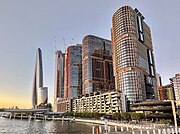Architecture of Sydney


Thearchitecture ofSydney,Australia’s oldest city, is not characterised by any onearchitectural style,but by an extensive juxtaposition of old and new architecture over the city's 200-year history, from its modest beginnings with local materials and lack of international funding to its present-day modernity with an expansive skyline of high rises and skyscrapers, dotted at street level with remnants of a Victorian era of prosperity.
Under the tenure of early nineteenth-centuryGovernorLachlan Macquarie,the works ofFrancis Greenwaywere the first substantial buildings for the fledgling colony. Later prominent styles were theVictorianbuildings of the city centre created out of localSydney sandstone,and the turn of the centuryFederation stylein the new garden suburbs of the time.
With the lifting of height restrictions in the post-World War II years, much of central Sydney's older stock of architecture was demolished to make way forModernhigh rise buildings – according to Singh d'Arcy, inThe Apartment House(2017), "From the 1950s onwards, many of Sydney's handsome sandstone and masonry buildings were wiped away by architects and developers who built brown concrete monstrosities in their place. The 1980s saw uncomfortable pastiches of facades with no coherence and little artistic merit".[1]Despite this, Sydney is still home to Australia’s oldest public building,Old Government House,located inParramatta.
Sydney's notable new buildings were designed by the Austrian-Australian architectHarry Seidler,as well as by international architects such asJørn Utzon,Jean Nouvel,Richard Rogers,Renzo Piano,Norman Foster,andFrank O. Gehrythroughout the 1960s up until the 2010s.
1788–1820s: The new colony's restrained Georgian style[edit]

The British established a colony inSydney Covein January 1788 after theFirst Fleetsailed 9 months fromPortsmouth.The early years of the colony suffered from a sense of provisionality and the attitude of the majority of convicts and their guardians that they would return to Britain once they had "done their time." The colony was poorly equipped, had little food supplies, and did not understand the climate or soil. For its first two years it faced starvation. In 1790, GovernorArthur Phillipbegan the process of freeing convicts and granting them land, such as that atRose Hill20 km inland which provided a stable food supply to the colony.[2]

The British Government did not provide architects, builders to the new colony, or useful tools. Request for building tools were responded to tardily with more inappropriate tools, which was seen as a sign that the British Government was reluctant to invest money in a penal colony, even though the number of free settlers was increasing. Amateur builders took time to work out what local materials were suitable. Those significant buildings that were built were of such poor workmanship and materials that they needed constant maintenance. LieutenantWilliam Dawesproduced a town plan for Sydney in 1790 but it was ignored in the under-resourced and often lawless society, and Sydney's layout still shows this lack of planning.[2]The earliest significant buildings in Sydney were simple restrained Georgian buildings that were suited to the climate (often by virtue of deep verandahs), available materials and craftsmanship, and were based in a spirit of making do and improvisation.[2]

Governor Macquarie's tenure began in 1810 and he promoted the idea of Sydney as a successful society of free citizens. He commissioned a survey of all aspects of the colony including its buildings which he found to be in a "most ruinous state of decay". He implemented a basic building code with certain minimum standards for new buildings and a requirement that every plan was to be submitted for new buildings. He saw his role as one of nation-building with a responsibility to provide facilities that were functional and provided a sense of community pride. By the end of his tenure, Macquarie had overseen the construction of 92 brick buildings, 22 stone buildings, 52 weatherboard houses, four bridges, seven quays and moles, and over 200 miles of road. In 1814,Francis Greenway,a convict serving a fourteen-year sentence for forgery, arrived in Sydney.
Over a short period of time, a partnership between him and Macquarie saw the construction of fine public buildings that were classically inspired, restrained decoratively and well-portioned and includedHyde Park Barracks,St James Church,St MatthewsatWindsor,and Old Liverpool Hospital atLiverpool.An 1819 commission of inquiry into the colony accused Macquarie of extravagance particularly in regard to construction and he was recalled to England. This effectively ended Greenway's career and little public construction was carried out until the late 1830s.[2]
1830s–1850s: eclectic neo-Gothic[edit]

Population growth,the granting of perpetual leases on town properties, the encouragement of free trade and exports underpinned a booming economy. Since the beginning of the colony, officers and administrators were housed on the eastern side of theTank Stream,while lower ranks and commerce was consigned to the western side. By the 1830s this had become entrenched with fine homes on the Potts Point ridge. The derivativeneo-ClassicalGeorgianstyle was being replaced with the more ornate and eclecticGothic Revival.John Vergewas the most renowned architect in the 1830s and his buildings includedTusculumin Potts Point,Elizabeth Bay House,andCamden Park.[2]
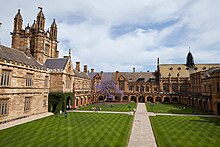
The 1840s saw an increasingly buoyant economy and confident society pushed along by the end of convict transportation and the commencement of an independent legislature. A building boom embraced theneo-Gothicstyle whereby the colony's strong need to identify with the home country was manifest.[2]Public, commercial and domestic architecture overlooked the local climate in favour of styles transported from Britain, and projects with substantial budgets often produced an indiscriminate eclecticism. Conversely, projects with limited budgets that precluded ostentatious and derivative design often resulted a kind of vernacular style that responded to local conditions. Rather than a connecting device between rooms, the verandah became a sun-shading device, and solid sandstone walls and cross-ventilation stabilised both cold and hot temperature extremes.[2]
1850s – Victorian architecture[edit]

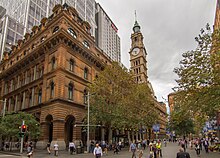
Victorian aspirations for respectability, formality, and materialism were compounded in Sydney by colonial yearning for respect, which in architecture resulted in the copying of imported styles, mostly from Great Britain. New wealth and rapid increase in population came with the 1850s gold rush. A new middle class emerged who wanted homes, cities and public buildings that matched their new wealth and social status and construction of high quality buildings such as churches, commercial and public buildings, and ostentatious houses of the wealthy boomed. On the other hand, housing for the working and lower middle class remained substandard and the prevalence of unhygienic and slum conditions grew. In the 1860s, architecture in Sydney focussed more on style than consideration of the building's function in relation to its setting and climate. An increase in Italian immigrants influenced residential construction which manifest itself in a growing popularity of surface ornamentation, plasterwork, squared massing, arcades and loggias, and square towers. The simplicity of early colonial architecture was replaced by decorative facades using ornate cast iron with higher ceilings featuring elaborate mouldings.
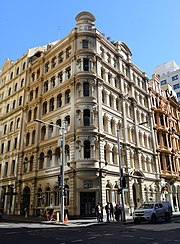
Major new civic buildings includedEdmund Blacket's Main Quadrangle Building at theUniversity of Sydneycompleted in 1859.James Barnetwas Colonial Architect from 1862 and was Sydney's most prolific Victorian architect.[3]His buildings includedThe Australian Museum(1864),Customs House(1884), theGeneral Post Office(1890), theLands Department Building(1881 & 1893) and theChief Secretary’s Building(1878). He also was responsible for many suburban post offices, court houses and other civic buildings. Most of Sydney's public buildings from this time, including Barnet's, were built from local stone and were a variety of styles includingItalianate,Gothic,and neo-Classical with heavily worked façades. The early 1860s saw a renewed interest in the use of brick. Mass production of bricks commenced in the 1870s, although hand production continued until the end of the 19th century.

By 1880, two-thirds of the population had been born in Australia and a growing nationalism viewed the country as paradise compared to theOld World.With a booming economy, Australians sought to prove they could compete with the Old World–during this time many Australian department stores, coffee houses and grand hotels were constructed. Most of them were built in the larger cities of Sydney and Melbourne, and some still stand in Sydney today.Anthony Hordern & Sonsand theAustralia Hoteldid not survive, however theGrace Building(The Grace Hotel), completed in 1930, is leftover as an example from the flourishing period in Australia that ran from the 1880s until the late 1920s. Built in the then relatively newart decostyle, The Grace was "designed to use the first two storeys in the manner of a department store. The remaining storeys were intended to provide rental office accommodation for importers and other firms engaged in the softgoods trade".[4]
Inter and Post World War[edit]

The Great Depression and World War II created a severe housing shortage for Australia in the late 1940s.[citation needed]A shortage of materials and skilled labour compounded the shortages, as did restrictive bank lending practises whereby it was the norm for borrowers to put up a deposit of 50% of the value of a house. Building plots of around 115 square metres aggravated the problems further. These factors fed a building industry recession and the cost of building home in the decade following the war grew by 600%.[5]In response, young architects who had worked in Europe and returned to Australia brought a simplicity to design and construction and renewed interest in logical structure and free planning. Verandahs and porches were less common on houses, and slightly pitched roofs replaced hipped roofs. Designs no longer featured non-functional ornamentation, ceilings were lower and rooms were expected to be multi-purpose. Vestibules were eliminated, hallways, and separate dining and living rooms were eliminated and the main entry was directly into the living room.[5]
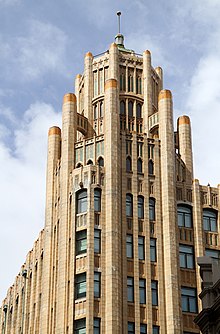
Harry Seidlerwas instrumental in the introduction ofInternationalismto Sydney. He studied underWalter GropiusatHarvard,worked withMarcel Breuer,and had been tutored byJosef AlbersatBlack Mountain College.TheRose Seidler House,for his parents, was the first of 10
buildings he built in Sydney between 1948 and 1952. The house was a revelation to conservative 1950s Sydney.[6]

In contrast to Seidler's strongly European flavour of Modernism was the softer form practised by the so-calledSydney Schoolof the 1950s and 1960s. This loose collection of architects, comprising, among others, Bill Lucas,Bruce Rickard,Neville GruzmanandKen Woolley,favoured organic and natural houses, often built on steep slopes and hidden from view in natural bushland. These projects were largely on the city'sNorth Shore,and to a lesser extent in theEastern Suburbs.Following on fromWalter Burley Griffin's work in the Sydney suburb of Castlecrag, this style of Australian architecture was visually sensitive to the environment and, like Griffin, often utilised natural local materials as structural elements.[7]
In thecentral business district,the lifting of height restrictions heralded the beginning of the city's change into a largely high-rise city.[5]
Opened in 1973, theSydney Opera Housewas designed by Danish architectJørn Utzon.[8]Its construction was partly financed by the Opera House Lottery. Utzon left under acrimonious circumstances before the building was finished; later work was completed by other architects. Located onBennelong PointonSydney Harbour,the building is aWorld Heritage Site.[9]The tallest point in the city is theSydney Towerbuilt in the late 1970s-early 1980s, when height restrictions were far more lenient. The observation tower provides views of the entire city.
Sydney is home to Australia's first building by renowned Canadian architectFrank Gehry,theDr Chau Chak Wing Building(2015), based on the design of atree house.An entrance fromThe Goods Line–a pedestrian pathway and former railway line–is located on the eastern border of the site.One Central Park,completed in 2014, is a mixed-use building located inChippendale.[10]Developed as a joint venture betweenFrasers PropertyandSekisui House,it was constructed as the first stage of theCentral Parkurban renewal project.[11]It consists of two high-rise apartment buildings, and features verticalhanging gardens.In 2013, One Central Park was awarded a 5 star Green Star – 'Multi-Unit Residential Design v1' Certified Rating by theGreen Building Council of Australia,making it the largest multi-residential building (bynettlettable area) in Australia to receive such a designation.[12][13]
Heritage laws: poor attitudes to historic buildings throughout the 1970s to the 2000s[edit]

Sydney lost most of its notable inter-war cinemas between the mid-1960s and the mid-1980s, including the Winter Garden atRose Bay,the Odeon atManlyand most disgracefully of all TheRegentin George Street, where the property developer had purchased the structure cheaply, only to pull it down. Whole classes of buildings remained under threat.
—Peter Spearritt, 2016[14]

Historic preservation exists in Sydney and is overseen by theNew South Wales State Heritage Register,established in 1999. Some of Sydney's grandest edifices have been replaced with contemporary architecture, a trend which began in the 1960s and has continued throughout to the present day. Lax heritage conservation in Sydney has attracted the ire of Sydneysiders, who are often in opposition to what government or local authorities want for the city, something seen recently with government contesting the heritage-status of theSirius buildingatThe Rocks.[15][16]The demolition of theRegent Theatreon George Street in 1988, which had been slowly falling into disrepair, is a reflection of the shoddy heritage attitudes that persisted in the 20th-century, despite protests from Sydneysiders and pleas forgreen bans:the ornateFree Classical-style theatre was purchased cheaply by property developerLeon Fink,who subsequently demolished the building days after purchasing it.[17]Sydney Mayor Clover Moore, then the MP for Bligh, addressed a crowd in Martin Place in 1988 to help save the building.
Another example of a recent demolition of a Sydney building was the loss of the head office of the Rural Bank at 52Martin Place.Theart decobuilding, designed in the 1930s by F.W. Turner, was controversially demolished in 1983 for a "modern" State Bank tower.[14]Despite staunch public protest, building's design significance and a listing in the Australian Heritage Commission listing were unable to prevent it being destroyed. Articles inThe Sydney Morning Heraldon 2 February 1982 ran spreads about protecting the building at public meetings organised by the Australian Institute of Architects.
Another controversial demolition of a prominent Sydney building wasAnthony Hordern & Sons,once Sydney's largest department store. The building was constructed in 1905 with an entrance inItalianmarblein aVictorian style.The Anthony Hordern Brickfield Hill site, Palace Emporium, was subsequently used by the NSW Institute of Technology (nowUTS) for some years. The emporium buildings were controversially demolished in 1986 for theWorld Squaredevelopment, which remained a hole in the ground for nearly twenty years, before finally being completed in 2004. Despite the hugely contested and much lamented demolition, there are some legacies remaining in Sydney, such as theHordern Pavilion,Hordern Towers (within the World Square development), and thePresbyterian Ladies' CollegeinCroydonof which its oldest building, 'Shubra Hall' was the home of Anthony Hordern III until 1889.[citation needed]
...[Sydney]'s older architecture had seen little investment, or [the buildings] were being allowed to disintegrate until their destruction.
— Sydney,Delia Falconer[18]
Notable lost buildings[edit]
-
Hotel Metropole
-
Commercial Travellers Club
-
The Colonial Mutual Association Building in Sydney, corner of George andWynyardStreets, circa 1900s.
-
Henry Bull & Co. Building
Prominent styles[edit]

Gothic Revival[edit]
- Government House,Bennelong Point
- St Philip's Church,Clarence Street
- Bishopscourt,Greenoaks Avenue,Darling Point
- The Abbey,Johnston Street,Annandale
- Gladeswood House, 11 Gladeswood Gardens,Double Bay
- St John's Church,Darlinghurst Road,Darlinghurst

Georgian[edit]
- Durham Hall,Albion Street, Surry Hills
- Cleveland House, Bedford Street,Surry Hills
- Waimea, Waimea Avenue,Woollahra
- Judge's House, 531Kent Street
- Juniper Hall,Oxford Streetand Ormond Street,Paddington

Neoclassical[edit]
- Customs House,Alfred Street,Circular Quay
- General Post Office,Martin Place
- Department of Lands Building,Bridge Street[citation needed]
- Art Gallery of New South Wales,The Domain
- State Library of New South Wales,Macquarie Street
- Australian Museum,College Street
- Darlinghurst Court House,Taylor Square

Romanesque[edit]
- Queen Victoria Building,George Street
- Church of St John, Bishopthorpe, St Johns Road,Glebe
- Société Générale House, 348George Street(originally the Equitable Life Assurance Society of America)
- Burns Philp Building,Bridge Street
- St Andrew's Church,56 Raglan Street,Manly
- Boothtown Aqueduct,Macquarie Road,Greystanes
Italianate[edit]
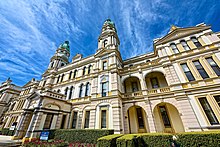
- Central Police Court,Liverpool Street
- Former New South Wales Club, 31 Bligh Street
- Chief Secretary's Building,Bridge Street
- Holyrood (facade), Santa Sabina College, The Boulevarde,Strathfield
- Rockwall, Macleay Street,Potts Point
- Stead House,Leicester Street,Marrickville
Federation/Edwardian[edit]
- Pyrmont Fire Station, Gipps Street and Pyrmont Bridge Road,Pyrmont
- YMCA,325Pitt Street
- FormerANZ Bank,52Oxford Street,Darlinghurst
- Former hotel, 2-4 Riley Street,Woolloomooloo
- Hotel building, 225George Street
- Commercial Building, 161Sussex Street
- Post Office,King Streetand Erskineville Road,Newtown
- Commercial building, 469Oxford Street,Paddington
- Bankstown Reservoir,300Hume Highway,Bankstown
Second Empire[edit]
- Sydney Town Hall,George Street
- Downing Centre(former Mark Foy building),Liverpool Street
Queen Anne[edit]
- Westmaling, Penshurst Avenue,Penshurst
- Caerleon, Bellevue Hill
- Homes,Appian Way, Burwood
Skyscrapers[edit]

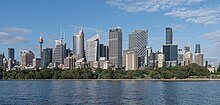
With 146 high-rise buildings over 90m, Sydney has thelargest skyline in Australia.[19]Height restrictions were lifted in the 1950s and theAMP BuildingatCircular Quaybecame Australia's tallest building several years later. The late 1980s and early to mid-1990s saw a skyscraper boom in Sydney, but height restrictions limited future buildings to the height of 235 metres, in part due to the close proximity ofSydney Airport.The largest structure isCentrepoint Towerstanding at 309 metres, containing restaurants and observation decks. Although both theMLC CentreandWorld Towerare higher measured to roof at 228m and 230m respectively, the tallest conventional skyscraper measured to its spire tip is theCitigroup Centreat 243m, completed in 2000.Crown Sydney,currently under construction inBarangaroo,will surpass all of these buildings (with the exception of Sydney Tower) upon its completion as Sydney's tallest building at 271.3 m (890 ft).
Tallest buildings[edit]
- Crown Sydney 271m
- Citigroup Centre 243m
- Chifley Tower 241m
- Deutsche Bank Place 240m
- Meriton World Tower 230m
- MLC Centre 228m
- Governor Phillip Tower 227m
- Ernst and Young Tower 222m
- RBS Tower 219m
- ANZ Tower 195m
-
One Sydney Harbourunder construction in December 2022
Bridges[edit]
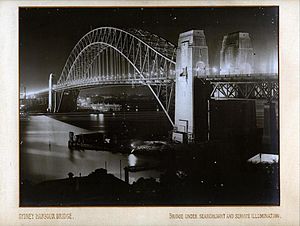
There are 23 major bridges within Sydney. There are no significantsuspension bridges.Instead, there is a mix of more modestgirder,trussandcable bridges.The most iconic bridge in the city, thethrough archSydney Harbour Bridge,links theNorth Shorewith the CBD acrossPort Jackson.The design was influenced byNew York City'sHell Gate Bridge.It is thesixth longest spanning-arch bridgein the world and the tallest steel arch bridge, measuring 134 m (440 ft) from top to water level.[23]TheAnzac Bridgeis an 8-lanecable-stayed bridgespanning Johnstons Bay between Pyrmont and Glebe Island.
-
Tom Uglys Bridge,crossingGeorges River
Residential architecture[edit]


Of the more than sixtyAustralian residential architectural stylesthat developed in Sydney over the years, more than half were used in residential architecture. Prominent residential styles included:
Old Colonial Period[edit]
- Georgian
- Regency
- Grecian
Victorian Period[edit]
- Free Classical
- Filigree (featuring wrought iron balconies)
- Italianate
- Gothic
- Queenslander
- Tudor
Federation Period[edit]
- Free Classical
- Filigree (featuring woodwork instead of wrought iron)
- Queen Anne(the dominant residential style between 1890 and 1910)[25]
- Bungalow(featuring prominent verandah)
- Arts and Crafts (including Shingle style)
Inter-War Period[edit]
- Georgian Revival
- Free Classical
- Mediterranean
- Spanish Mission
- Gothic
- Old English
- California Bungalow
Post-War Period[edit]
- International
- American Colonial
Late Twentieth Century Period[edit]
- Organic
- Sydney regional
- Tropical
- Late Modern
- Australian Nostalgic
- Immigrant Nostalgic
-
Many of Sydney's terraces have been subjected togentrification,such as these inKirribilli.
-
Terraces are common and widespread in older suburbs, such as theseFiligreestyle terraces in Glebe
-
An Italianate home inRandwick,New South Wales
-
Merrivale, a home in theRegency style,Pymble
-
Two-storeyBungalow,Cremorne
-
Caerleon,Bellevue Hill, New South Wales,the firstFederationQueen Anne home in Australia
-
Pibrac, a home in theShingle style,Warrawee (designed byJohn Horbury Hunt)
-
Horbury Terrace apartments inGeorgian style,Macquarie Street
-
Cottage inArts and Crafts style,Bondi Junction
-
Fernlea, aFederationBungalow,Wahroonga, New South Wales
-
Contemporary home, Mosman
-
TheRose Seidler Housein the city'sNorth Shorewas the firstModernist/Internationalist style building in Sydney. It is now open to the public as a museum.
-
Old Englishhouse common withinKillara
-
Tudor Revivalhouse in Killara
See also[edit]
- List of heritage houses in Sydney
- List of Art Deco buildings in Sydney
- Australian non-residential architectural styles
- Terraced houses in Australia
- Architecture of Melbourne
References[edit]
- ^Butler, Katelin; Bruhn, Cameron (2017).The Apartment House.Thames & Hudson. p. 100.ISBN978-0-500-50104-7.
- ^abcdefgMcGillick, Paul; Bingham-Hall, Patrick (2005).Sydney Architecture.Singapore: Tuttle Publishing. pp. 14–15.ISBN0-7946-0334-3.
- ^Barnet, James (29 July 1899)."Architectural Work in Sydney New South Wales 1788-1899"(PDF).Journal R.I.B.A.VI(17): 503–518.Retrieved13 July2015.
- ^"Grace Building".New South Wales State Heritage Register.Department of Planning & Environment.Retrieved10 October2017.
 Text is licensed by State of New South Wales (Department of Planning and Environment) underCC-BY 4.0licence.
Text is licensed by State of New South Wales (Department of Planning and Environment) underCC-BY 4.0licence.
- ^abcMcGillick, Paul; Bingham-Hall, Patrick (2005).Sydney Architecture.Singapore: Tuttle Publishing. p. 106.ISBN0-7946-0334-3.
- ^McGillick, Paul; Bingham-Hall, Patrick (2005).Sydney Architecture.Singapore: Tuttle Publishing. p. 108.ISBN0-7946-0334-3.
- ^"So last century".The Sydney Morning Herald.13 April 2006.
- ^House HistoryArchived16 July 2006 at theWayback Machine;Sydney Opera House websiteArchived2 March 2011 at theWayback Machine(accessed 2006-07-24)
- ^Entry for Sydney Opera House;UNESCO World Heritage Centre(accessed 2006-07-24)
- ^"Central Park Sydney".centralparksydney.Retrieved29 August2015.
- ^"Frasers Property - Central Park, Sydney".frasersproperty.au.Retrieved24 August2015.
- ^"Central Park receives its first three 5 Star Green Star ratings"(PDF).Fraser Property.30 October 2013. Archived fromthe original(PDF)on 1 March 2015.Retrieved21 August2015.
- ^"Central Park receives its first three 5 Star Green Star ratings".sekisuihouse.au.Archived fromthe originalon 10 March 2015.Retrieved24 August2015.
- ^abO'Callaghan, Judith; Hogben, Paul; Freestone, Robert (2016).Sydney's Martin Place: A Cultural and Design History.Allen & Unwin.ISBN978-1-76029-362-8.
- ^"Sirius sell-off: 'They don't think people like me should have these views'".Sydney Morning Herald.6 August 2016.
- ^"Age-old appeal: Why Sydneysiders are clamouring to buy heritage apartments".Domain.13 October 2017.Retrieved5 February2019.
- ^"PS Spotlight: Exhibition projects insight into past of city's picture theatres".1 September 2017.Retrieved21 December2019.
- ^Falconer, Delia (2010).Sydney.University of New South WalesPress Ltd. p. 87.ISBN978-1-921410-92-5.
- ^The World's Best Skylines
- ^Daily Telegraph11 June 2014, p.6
- ^"Widest Bridge".Guinness World Records.Retrieved15 September2012.
- ^"Port Mann Bridge".TRANSPORTATION INVESTMENT CORPORATION.British Columbia: Province of British Columbia. 2007. Archived fromthe originalon 11 September 2012.Retrieved15 September2012.
Once complete, the new 10-lane Port Mann Bridge will the second largest and longest cable-supported bridge in North America, and at 65 metres wide it will be the widest bridge in the world.
- ^"Sydney Harbour Bridge".culture.gov.au.Australian Government.Retrieved1 October2010.
- ^"HMS - ViewItem".hms.heritage.nsw.gov.au.Retrieved19 January2022.
- ^A Pictorial Guide to Identifying Australian Architecture, Apperley (Angus and Robertson) 1994, p.132
External links[edit]
- Sydney Architecture Walks, architect-led tours of Sydney
- Archiseek: Sydney
- The City, Sydney walking tour by Sydney Architecture Walks
- Five Suburb Sydney Dérive - architectural bike tour by Sydney Architecture Walks
- Sydney City Architecture WalkbyAustralian Architecture Association
- Walk Through Time in Sydney CitybyAustralian Architecture Association*A mapping of historic buildings in the inner city
- Gallery of Buildings in Sydney
- Gallery of Sydney Architecture
- Australian Architectural Styles
- The Skyscrapers of Sydney - A video guide to the Sydney skyline
- Dictionary of Sydney - Buildings
- Sydney Building Blog
- Trevor Hall Architects Sydney.





